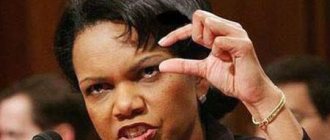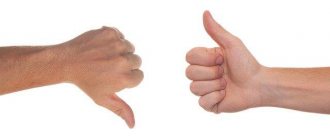negotiations for managers
15.07.2020
Author: Academy-of-capital.ru
Add a comment
Rating:
| (Votes: 3, Rating: 4.33) |
From this material you will learn:
- The need to understand nonverbal communication.
- Differences between verbal and nonverbal communication.
- 6 means of nonverbal communication.
- What do these or other gestures mean?
- Postures for open communication and alarming ones.
- 19 types of facial expressions.
- Psychology of wardrobe.
Nonverbal communication is what brings a person to the surface. If he says one thing, but demonstrates something else with his gestures and facial expressions, then you shouldn’t do business with him, since he is either hiding something, or keeping something back, or even worse, lying. In addition, gestures, voice timbre and clothing can also say a lot about the interlocutor.
Everyone needs to know all the tricks of nonverbal communication, not only in order to figure out the interlocutor. This knowledge will help you behave when communicating with people according to the thoughts in your head, demonstrating sincerity and not giving rise to doubts.
The need to understand nonverbal communication
Let's start with the fact that nonverbal communication is body language (gestures, postures, intonations), influencing a person through facial expression and demeanor, that is, non-verbal transmission of information without words. Experts often call this type of communication nonverbal.
The history of bodily signals began much earlier than verbal communication. Ancient people expressed themselves by body movements (tilting the head, waving the arms, moving the body). By analogy with animals, man put different meanings into dynamics. Later, people began to make sounds in the form of mooing. Timbre and intonation appeared, now called paralinguistics. Much later, methods of verbal communication emerged that complemented existing communications.
Today, nonverbal communication in the communication of a modern person makes up 60%. This is what we express with gesture, posture, facial expressions. Another 30% of information is conveyed through intonation and vocal sounds. As a result, 90% of the information a person communicates is not perceived from the meaning of the speech.
Typically, wordless communications occur subconsciously and very rarely occur intentionally. Therefore, specialists who understand body language are able to read a lot from gestures. Undoubtedly, it is easier to use speech, but many do not even think that they can give signals through movement, facial expressions and gestures, and therefore do not try to control them. But a person who understands this issue is able to understand the true attitude of the interlocutor by reading non-verbal signs. After all, they reflect a person’s real feelings, his attitude to what is happening and the environment.
But there is another side to the issue. Nonverbal communication between people is a great clue for specialists. Someone who is good at non-verbal communication, which is quite possible, will express their thoughts clearly. In any case, those around him will understand him more accurately.
Body language is often used for personal manipulation, as well as manipulative games. All these actions influence the subconscious of the partner, who does not understand them and instinctively submits to someone else’s will. Misunderstood non-verbal language is fertile ground for manipulation in everyday life.
Differences between verbal and nonverbal communication
Let us recall what verbal interaction is. These are verbal communications between people. They are oral and written. The main conditions for contacts are clear content, clear pronunciation, and clear expression of thoughts.
Language, as a data encoding system, is the main tool for communication. It allows you to describe objects and events, express personal opinions, show emotions and feelings. However, this mechanism of communication makes sense together with certain actions. That is, spoken words must be supported by signs to enhance the effect of interaction.
Note that dactylic speech, which deaf and mute people “speak”, also belongs to verbal communication. Here gestures replace letters.
Taking into account all the definitions, we can conclude that nonverbal communication (signals) differs from verbal communication only in the form of information transmission. The latter involves the use of oral speech or written expression of thoughts. More precisely, the interlocutors convey information to each other in the form of words. This type of communication is only available to people.
The principle of nonverbalism is based on body language. Therefore, the main means of interaction here are postures, gestures, facial expressions, and touches. They perfectly help a person express his thoughts without using words. But at the same time, facial expressions and gestures are characteristic of animals. You obviously know why a dog or cat wags its tail? The first demonstrates its joy, the second - a feeling of dissatisfaction. The beast’s menacing grin warns a person, and a guilty look symbolizes repentance. There are many such examples.
Science has proven that nonverbal communication is much more sincere than verbal communication. The reason is that people are often unable to control their gestures and facial expressions. These are internal signals from the subconscious that reflect everything we experience.
Undoubtedly, speech (both oral and written) is often deceitful. After all, deceiving people over the phone or the Internet is easier than having a conversation in person. When meeting, you can observe the facial expressions and gestures of the interlocutor to notice the obvious discrepancy between emotions and words. To understand how nonverbal and verbal communication differ, let's give a simple example.
Let's say if a seller tells you about the benefits of a product, looking away and nervously fingering some object, it means he is hiding something. As you can see, it is easier to deceive with words than with facial expressions and hand movements.
Proxemics
Proxemics (spatial movements) - distance, orientation, placement at the table. It identifies the areas of most effective communication.
Distance. American anthropologist Edward Hall, founder of the science of proxemics, identifies four main zones of communication:
- Intimate zone (15-45 cm) - only people who are close to each other can enter this zone. In this zone, a calm, confidential conversation is conducted, and tactile contacts are established. The invasion of a “stranger” into this zone is perceived as a threat;
- personal zone (45-120 cm) - an area for relaxed communication with friends and colleagues. Only visual contact is allowed;
- social zone (120-400 cm) - area for official discussions and negotiations, meetings and administrative conversations
- public zone (400-750 cm) - an area of communication with large groups of people at lectures, meetings, public speaking, etc.
People generally feel comfortable and make a favorable impression when they are at a distance appropriate to the above types of interactions. Being too close or too far away has a negative impact on communication. If a stranger tries to cross your personal distance, you will instinctively take a step back or extend your arms to prevent the invasion of your personal space. You may feel anger, increased heart rate, or a rush of adrenaline. If you are in a situation where an intrusion is inevitable (elevator, crowded transport), we recommend that you try to remain calm, do not talk to him, it is better to refuse even non-verbal contact with him (do not look the person in the eyes).
It should be noted that the rules regarding communication zones depend on the age, gender, personality and social status of the person, as well as on his nationality and population density in the area of residence. For example, children and older people tend to be closer to their interlocutors than teenagers, young adults and middle-aged people. Men prefer a more distant position than women. A well-adjusted person moves closer to the interlocutor, while restless, nervous people stay further away. People communicate with interlocutors of higher status at greater distances. Asians interact over greater distances than Europeans, and city dwellers interact more closely than those living in sparsely populated areas. In rural areas, the concept of “personal space” is much broader than in cities. As a result, a rural resident often experiences significant discomfort while in the city.
Orientation. One should also take into account such prokeine components of the nonverbal system as orientation (angle of communication). Orientation is the position of partners relative to each other, which is expressed in the rotation of the body and toes towards or away from the partner, signaling a desire or reluctance to communicate. This arrangement of partners can vary from “face to face” to “back to back” and, accordingly, from cooperative to competitive communication.
What do certain gestures mean?
- Unbuttoning a jacket
This is a sign of openness that involves non-verbal communication. Situations when well-meaning people tend to unbutton or take off their jacket in front of their interlocutor are quite common. Practice shows that negotiators in loose clothes are more likely to find compromises than those who are buttoned up with all the buttons. It has been noticed that when making a positive decision, a person usually unclasps his fingers and instinctively pushes the tails of his jacket apart.
When partners realize that they have almost achieved a positive result in the issue under discussion or have worked fruitfully for the benefit of both parties to the negotiations, they tend to unbutton their jackets, straighten their legs and move closer to the edge of the chair in order to get closer to the table and, accordingly, to the opponents sitting opposite them. .
- Mistrust and secrecy
These gestures indicate the interlocutor's suspicion. That he doesn’t believe your words or is hiding something himself. In such situations, people involuntarily rub their chin, forehead or temples, and try to cover their face with their hands. Most often, such individuals look away so as not to look into their partner’s eyes. Another sign of secretive behavior is uncoordinated gestures. If the “aggressor” or your “victim” smiles, then his hostility is hidden behind the insincere smile.
- Protection
With defensive gestures, people show a sense of threat and danger. The most popular sign from this series is crossing the arms in the chest area. When speech is absent, nonverbal communication involves three characteristic situations, which we will describe below.
The usual crossing of arms is a standard gesture that symbolizes dissatisfaction or a defensive posture of the interlocutor. You should change your negotiation strategy, otherwise your opponent will try to avoid answering specific questions. In addition, this sign influences the position of others.
If one of the four participants in a conversation crosses his arms over his chest in defense, it is quite possible that everyone else will follow his example. Of course, in some cases this can be seen as self-confidence and serenity. But only if the conversation is favorable.
We recommend
“Verbal communication: understanding the types and applications” Read more
It happens that in addition to crossing your arms, your opponent clenches his fists. This is a typical sign of aggression and hostility - the negotiator goes on the offensive. You need to slow down your speech and reduce the intensity of your gestures, intuitively inviting your interlocutor to moderate his ardor. If that doesn't work, change the topic of conversation.
Sometimes people criss-cross their shoulders with such force that their fingers, digging into their biceps, turn white. In this way, they restrain the negative emotions that arose in response to your proposal on the current issue. A similar gesture is used if one of the negotiators gets into a discussion, trying to impose their position as the only correct one. In addition to this pose is added a cold gaze with a squinted eye and a tense smile. This body language means that the person is, so to speak, on edge and urgently needs to change tactics in order to reduce tension and avoid conflict.
Quite popular in business circles are arms crossed over the chest with thumbs raised vertically. Nonverbal communication interprets this signal as “two in one”. It means denial (arms crossed) of your position plus your own superiority (hand position). The person using this technique often plays with their fingers or rocks slightly on their heels while standing. The contemptuous gesture of the thumb symbolizes ridicule and disrespect for the one at whom it is supposedly directed over the shoulder.
- Thinking, evaluation
Such gestures demonstrate the work of thought to solve a problem. Thoughtful facial expressions are often accompanied by hands supporting the cheeks. This body position indicates that the opponent is interested in something. You just have to recognize what he was so focused on.
- Tingling between the eyebrows
This is usually done with the eyes closed, which means greater concentration of the mind and intense work of thought. At the problem-solving stage, when the answer is already ready, the interlocutor rubs his chin. Many people accompany their thought process by squinting their eyes, as if looking at distant objects in search of the necessary solution.
- Doubt and indecision
The movements that nonverbal communication dictates to us in this case consist of stroking the side surface of the neck or the area under the earlobe with the index finger (usually 5-6 times). A sign of hesitation will be touching your nose and lightly scratching its tip.
- The desire to isolate yourself
If the interlocutor runs his fingers along the edge of the ear, this means that he does not want to hear your words. Tugging on the earlobe warns the speaker that the person has heard enough and also wants to state his position.
- The desire to leave the interlocutor
When your counterpart intends to stop the dialogue, he slowly (or purely mechanically) turns his body towards the door, pointing his legs towards the exit. The interlocutor seems to demonstrate that he needs to leave. There is another expressive gesture that speaks without words: a man demonstratively takes off his glasses and puts them in a case. Here you need to do something to attract the opponent’s attention or just let him leave. Continuing the conversation in the same spirit will not achieve results.
- Dragging out the conversation
Such gestures are often associated with glasses. To gain time to make a decision, the opponent does this: he takes off his glasses and puts them back on, and wipes the lenses. Once you notice this reaction to a question asked, just wait silently. The interlocutor, putting his glasses back on, shows that he needs to “look at the arguments” again.
- Walking from corner to corner
Another technique that offers people non-verbal communication. A person pacing around the room is sending you a signal - “you shouldn’t rush.” It is used to stall for time when solving complex problems. This is essentially a positive gesture. Don't distract the other person who is walking, otherwise you will interrupt his thoughts and prevent him from making a decision.
- Keep yourself in control
If a person is too upset and wants to curb his emotions, he grabs his wrists behind his back. This gesture should not be confused with the “lock your hands behind your back” position. An interesting fact: the greater the degree of anger, the higher the hand is raised from behind. This is where the phrase “pull yourself together” came from. This negative movement can hide nervousness, but an observant negotiator will sense this signal.
- Disapproval
In other words, these are gestures of repression that arise from unspoken opinions. Let's say the collection of invisible lint on clothing is an example of such a reaction. The participant in the conversation does not like everything that is happening, even if outwardly he agrees. The person who is looking for lint usually sits without looking at others or with his eyes on the floor. This is the most common way to show dissatisfaction.
- Willingness to leave
This body position indicates a desire to end the conversation. In this case, the body is tilted slightly forward, hands are on the knees or holding the seat of the chair. If you notice these movements in a conversation, it’s time to end it and be the first to say goodbye to your opponents. This way you will maintain your priority and maintain control over the situation.
Considering nonverbal communication (features of popular poses and gestures), it should be noted that there are a lot of other techniques that quite expressively convey the state of mind. For example, rubbing your palms reflects joyful anticipation. Intertwined fingers represent the collapse of hopes and the desire to hide one’s annoyance at what one hears.
Postures for open communication and alarming ones
The ideal position for a frank conversation is open. What do these signs of nonverbal communication look like (gestures, postures, facial expressions):
- hands lie freely on the table, knees or armrests;
- the upper part of the body is straight, but not tense (no need to fall apart in a chair or sit as if you had swallowed a yard);
- the legs stand straight and natural (a crossed position is undesirable), but the “leg to leg” pose is possible and indicates the liberation of the interlocutor;
- attentive, calm look into the eyes;
- keep your head straight (without tilting left or right), do not look from under your brows and do not raise your nose;
- relax, lower your shoulders.
Nonverbal communication in closed positions indicates the interlocutor’s discomfort and his desire to get out of an uncomfortable situation.
What do sitting body positions mean:
- Standard foot-to-foot manner . A nervous, withdrawn person who tries to hide his own vulnerability. The person has a negative attitude towards conversation.
- "American" pose . Warns that your partner is going to challenge or object to you. This is often how leaders and ringleaders behave.
- Completely closed position - crossing of arms (crosswise on the chest) and legs (one thrown over the other) . The opponent does not want to talk to you and is extremely negative.
- Indecisive position . The leg is thrown over the leg, the fingers are folded and hold the upper knee. The interlocutor wants to hide his excitement.
- Defensive position - interlocking feet . Often characteristic of shy people.
- Crossed ankles . They express an attempt to hide their fear, anxiety and negative emotions. The person who took this pose seems to be biting his lips to himself. Such provisions are chosen during inquiries, where it is necessary to control actions and words.
Handshake
A handshake, the most common tactic, is an indispensable attribute of any meeting and farewell. A handshake is a polyphonic gesture known since ancient times. Primitive people stretched out their hands with open palms to show their lack of weapons and peacefulness when meeting each other. The following types of handshakes and their characteristics can be distinguished:
- an energetic, energetic handshake of the interlocutor at the same time as a joyful exclamation shows the sincerity of the partner, his desire to continue the conversation;
- when the partners’ hands are in the same position, this is a demonstration of equality;
- The dominant handshake (hand held on top, palm down) is its most aggressive form. With a dominant (powerful) handshake, one person communicates to another that he wants to dominate the communication process;
- The submissive handshake (hand down, palm up) is demonstrated in situations where one person wants to let the other take the lead so that they feel in control;
- Squeezing your partner's hand in a "glove" shape (one person wraps both hands around the other's) indicates friendliness. However, this type of handshake should be used with people you know well, as it can have the opposite effect if the person is nervous;
- the depth of sensation depends on where the other hand is placed when shaking hands; the upper arm is better than the forearm, the forearm is better than the elbow;
- a long handshake with a smile and a warm gaze is an expression of affection;
- a longer handshake and sticky hands—excitement;
- a short, lazy handshake and dry hands - indifference;
- If a lifeless hand reaches out to you like a dead fish, don't mess with it;
- shaking hands with an extended, straight arm is a sign of aggressiveness. Your main goal is to keep your distance and not let the person near your private parts;
- A strong handshake until your fingers grind together is a sign of an aggressive, tough person.
Tapping on the back or shoulder. This tactical element is possible under the condition of close relationships and equal social status of the communicants. Patting is often interpreted as an expression of friendship, sympathy, or encouragement. These nonverbal gestures are usually characteristic of men. Pats him on the back, as if demonstrating masculine strength and the owner’s readiness to help.











